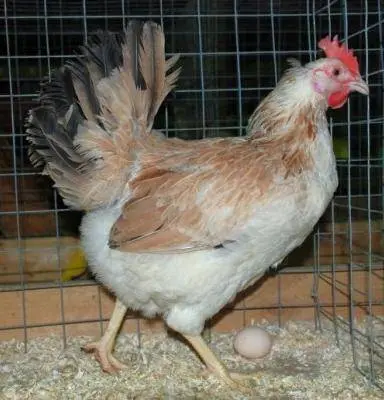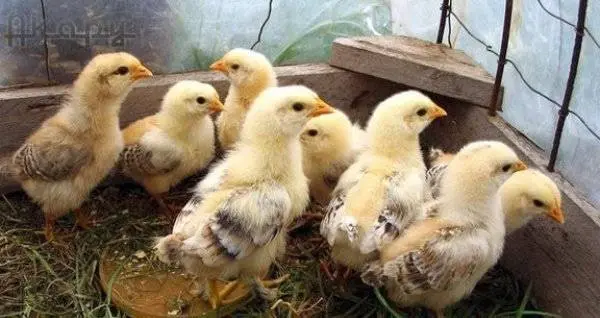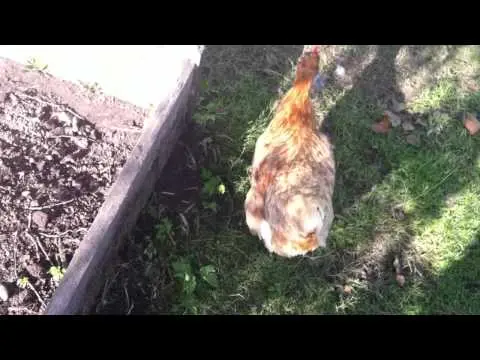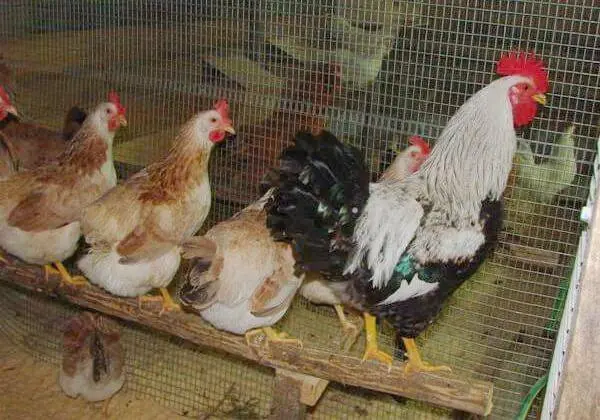Zagorsk salmon breed of chickens is a very successful Soviet breed, ideally suited for the harsh conditions of Our Country. A beginner who decides to start chicken farming, but does not know which breed to choose, can safely recommend Zagorsk chickens.
Derived from crossing four breeds at the Poultry Institute, located in the city of Sergiev Posad, this breed has become one of the most successful breeds of Soviet chickens. The name was given to her in honor of the old name of the city – Zagorsk.
Two and two foreign breeds of chickens were involved in the creation of the breed: Yurlovskaya vociferous and white; Rhode Island and New Hampshire.
From these breeds, Zagorsk salmon chickens took all the best: cold resistance, unpretentiousness in food, egg production, rapid weight gain and endurance.
Breed description
In Zagorsk chickens, sexual dimorphism is well expressed in color. The photo shows that the chickens have a fawn-colored feather, similar in color to salmon meat, hence the second part of the name “salmon”. Roosters are silver-black. So it is unlikely to be confused, even if this breed cannot boast of luxurious cock tails, as the photos below prove.


Zagorsk salmon are interesting for the ability to distinguish a chicken from a cockerel from the first day of life of chickens, which the vast majority of breeds cannot boast of.

On the video you can see how Zagorskaya salmon hatches:
The photo below shows a clear cockerel on the left and a hen on the right in the background.

Already on the fourth or fifth day, the flight feathers of the color characteristic of their sex begin to break through in the chickens: the cockerels are black, the hens are red.

If the owner has little experience and he is afraid of making a mistake, then you can wait up to three weeks when the chickens are fully feathered. At this age, it is no longer possible to confuse a chicken with a rooster.
Since the breed has a meat and egg direction, such a culling can be safely sent to the soup.
Zagorsk chickens gain weight very quickly. Already at three months, the weight of a young rooster should be 2 kg. An adult bird grows up to 3,7 kg of roosters and 2,2 kg of chickens.
At this growth rate, they are often hybridized to produce meat broilers. True, here you need to know certain nuances: when using Zagorsk salmon chickens for hybridization, the rooster must be Kurchinsky anniversary or corish; if a Zagorsk rooster is taken for hybridization, the chicken for it should be Adler silver or Hampshire.
For its direction, Zagorskaya is distinguished by a very good egg production. It is not uncommon for hens to lay more than 200 eggs a year. At the same time, chickens begin to lay eggs at the same age as industrial egg crosses: 3,5-4 months. Eggs weigh from 60 to 65 g, which, again, is comparable to industrial crosses. Thus, the Zagorsk breed of chickens loses to industrial egg hens only in the annual production of eggs.
If eggs from industrial breeds often have a thin, fragile shell, then the brown eggs of Zagorsk chickens have a dense shell. This increases the shelf life of eggs and reduces losses during transportation.
In chickens, egg production does not decrease when replacing a rooster in the herd or transferring the herd to another room, which is also a big plus for the breed.
There is a known case when the litter was changed from sawdust to straw for chickens, that is, the conditions of detention were improved. Egg production dropped and returned to normal only after a few days. The Zagorskys are likely to be indifferent to such changes.

There are no original features, except for the color, in the exterior of the Zagorsk salmon. It belongs to the so-called ordinary, because when it was launched, the emphasis was not on the original appearance, but on such characteristics as:
- meat and egg productivity;
- good response to feed;
- ability to consume bulk feed;
- omnivorous;
- high immunity;
- stress resistance;
- unpretentiousness in content.
The goals were fully achieved and now the Zagorsk salmon is considered the best chicken for the village.
The feed must be of high quality, but chickens can be given waste from the table.
Chickens have a good-natured character and a well-defined incubation instinct. They get along well with other breeds of chickens, and due to their high qualities as hens, Zagorsk laying hens can be used to breed chickens of other breeds.
Zagorskaya salmon. Characteristic.
Features of the content
Zagorsk salmon, with their rather serious weight, are tightly knocked down, taut and “sporty” chickens. What shamelessly use. Having the ability to take off to a height of 2 m, they easily fly over many fences that separate the poultry yard from the garden.
The Zagorskys are not deprived of observation either. Any hole leading to the coveted garden will certainly be discovered by them. And given the omnivorous nature of the Zagorsk salmon, which is usually defined in the description of the breed as a characteristic originally laid down when breeding this breed, you can be sure that they will certainly save you from the Colorado potato beetle. Because not a single pest of plants in their right mind and sober memory will live where nothing grows.
It is better to fight the beetle with more traditional methods, and for chickens to build an aviary closed from above, which will not allow the bird to roam where it wants.
Walking for Zagorsk salmon is, without exaggeration, vital. Keeping them in cages does not make the slightest sense, since their egg production decreases and the quality of meat deteriorates.
For spending the night, the Zagorsks need a warm chicken coop, preferably with a high perch. Chickens of any breed, if they can fly, prefer to spend the night as high as possible. The Zagorskys are no exception. The photo shows a good roost option for Zagorsk salmon.

Feeding
As a truly rural breed of chickens, Zagorskaya is not too demanding on feed, it can also look for food for itself. In the latter case, be prepared for the raids of the chicken horde on the gardens. And don’t be surprised if birds start preying on mice.
Zagorskie are happy to eat kitchen waste, but they should not be deprived of grain feed at all. They also respond well to feeding with chicken feed, which contains all the vitamins and trace elements necessary for chickens.
If the bird does not have the possibility of free range, coarse-grained sand should be poured into a separate bowl, which helps the chickens digest the food they eat. Feed chalk should be mixed into the feed in very moderate amounts.
As animal protein, chickens are given meat and bone and fish meal. You can also give finely chopped raw fish, but in this case you must strictly monitor that the chickens eat everything and the fish does not go rotten in the feeder. For the prevention of vitamin D hypovitaminosis, fish oil is introduced into the diet.
A good food for chickens can be a mixture of wheat with shells of small shrimp. The latter provide chickens with the necessary calcium and trace elements.
Chickens are fed with finely ground grains. In the early days, give a finely chopped boiled egg. It’s also a good idea to add powdered eggshells. Gradually begin to add chopped greens and vegetables.
Conclusion
Given the unpretentiousness of the Zagorsk salmon, the rapid weight gain of chickens and the fairly high egg production, the breed can be recommended to both amateur chicken breeders and novice farmers as a starting breed. Then you can switch to more productive, but also more capricious breeds of chickens, or continue to breed Zagorsk salmon.









